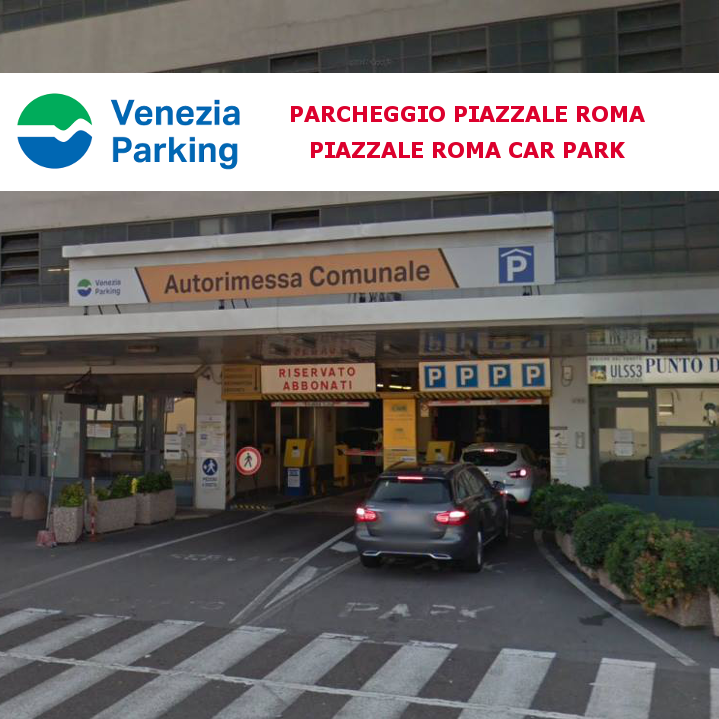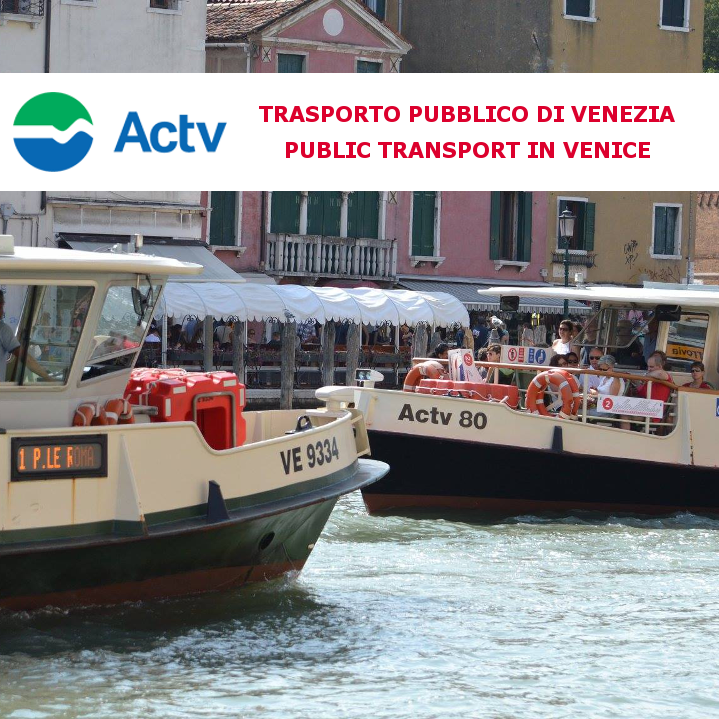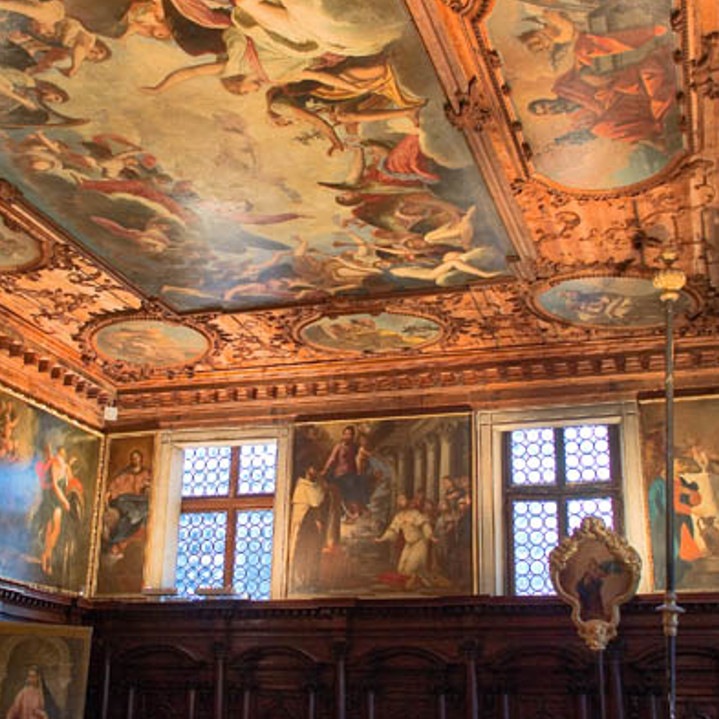You are here
Monumental churches, synagogues and Scuole Grandi: a multicultural walk in Cannaregio
Monumental churches, synagogues and scuole grandi: a multicultural walk in Cannaregio
This itinerary allows you to really get the feel of the Cannaregio district, passing through Castello and San Marco. Some sources indicate that the origin of the name “Cannaregio” derives from the contraction of the words “Canal Regio”, formerly used to indicate the main canal linking Venice to the mainland. However, others claim that it refers to “region of the reeds (canne)”, because of the marshes and reed beds once found in the area.
Our recommended itinerary takes you into the heart of the city, making your way along quieter routes and appreciating places steeped in historical and religious memories, authenticity and traditions, and passing through very important monumental urban areas.
The itinerary takes about three hours, which covers walking time and entry to the various churches that can be visited. If you wish, you can also add a visit to a museum or exhibition of your choice from those suggested. You can start the itinerary at any stage along the route, so it can vary in duration and distance to suit your requirements.
Back in 2017, the City of Venice launched the #EnjoyRespectVenezia awareness campaign to promote sustainable tourism. Please ensure that you always behave responsibly and respectfully towards the city, taking particular note of the following:
- Do not stop and stand on bridges
- Keep to the right
- Only purchase goods from authorised retailers
- Use licensed tour guides.
- Duration: 3 hours + 1 hour visit to a museum or exhibition of your choice
- Distance: 7 km
- Mode: On foot
- Suggested period: All year round
- Suitable for children: Yes
- Disabled access: Partial
- Departure: Santa Lucia Station / Piazzale Roma – Santa Croce district
- Arrival: Campo Santo Stefano – San Marco district
- Districts: Campo Santo Stefano – San Marco
-
Links with other itineraries: “Dorsoduro, the art district: from Venetian origins to international contemporary art”. Link from Campo Santo Stefano
“Naval art, craftsmanship and popular traditions: Venice’s Castello district”. Link from Campo Santi Giovanni e Paolo or from Campo Santa Maria Formosa
“Beauty mirrored in the water: discovering Giudecca and San Giorgio Maggiore”. Link from Campo dei Gesuiti
Itinerary details
- Departure: Piazzale Roma / Santa Lucia Station – Ghetto
- Stage 1: Jewish Ghetto
- Stage 2: Ghetto – Church of Santa Maria della Misericordia
- Stage 3: Misericordia - Ponte Chiodo - Campo dei Gesuiti - Calle Varisco
- Stage 4: Basilica of Santi Giovanni e Paolo - Scuola Grande di San Marco
- Stage 5: Campo Santi Giovanni e Paolo - Palazzo Tetta - Santa Maria Formosa
- Stage 6: Campo Santa Maria Formosa - Scala Contarini del Bovolo - Campo Manin
- Stage 7: Campo Manin - Palazzo Fortuny
- Arrival: Palazzo Fortuny – Campo Santo Stefano - Campo San Samuele
- Sources

Basilica of Santi Giovanni e Paolo and the facade of the Scuola Grande di San Marco
Departure: Piazzale Roma / Santa Lucia Station – Ghetto
Average time for this stage: 10 minutes
The itinerary suggested begins or ends at Piazzale Roma or Santa Lucia Station, depending on which direction you take, bearing in mind that you can start it at any stage.
If you arrive in Venice by train, when you come out of Santa Lucia train station, you will notice the imposing copper dome of the church known as San Simeon piccolo straight across the Grand Canal. The Venetians call it piccolo (small) to distinguish it from the larger nearby church of San Simeon Grando.
To the left of the station is the Church of the Carmelitani Scalzi, dedicated to St Mary of Nazareth, and one of the most admirable examples of Venetian Baroque architecture. Here, in addition to the church and the convent, there is also an ancient brolo, namely a vegetable garden protected by high walls, dating back to the mid-seventeenth century, where the friars grow herbs and flowers, including Melissa moldavica (Moldavian dragonhead). The Carmelite fathers extract the precious essential oil from this particular variety of medicinal plant and use it as the main ingredient in numerous herbal preparations, which have been made in the same way since 1710. The garden is also home to the oldest vines in the Serenissima, with varieties that have been present in the Venetian lagoon for hundreds of years. The best months to visit the garden are July and August.
To reach the entrance to the Jewish Ghetto when coming from Piazzale Roma, cross the Ponte della Costituzione (also known as the “Calatrava Bridge” in honour of the Spanish architect who designed it in 1997), then walk along Fondamenta Santa Lucia with the train station on your left, and continue along Rio Terà Lista di Spagna until you reach Campo San Geremia, where the church of Santi Geremia e Lucia is located. Founded in the eleventh century, rebuilt in the twelfth and given its current appearance in 1753, the church is now the Santuario di Santa Lucia. It houses the precious remains of the saint, transferred here in 1860 from the original church – no longer in existence – located in the urban area now occupied by the railway station.
Next to the Church of Santi Geremia e Lucia – adjacent to the terracotta bell tower, one of the oldest in the city – stands the imposing Palazzo Labia. The building was commissioned in the late seventeenth century by the Catalan Labia family, who acquired the noble title following the decision of the Maggior Consiglio – taken in 1646, during the terrible years of the plague – to “reopen the Golden Book of the Venetian nobility by paying one hundred thousand ducats into the state coffers”. The Labia family remained in the palace until 1852. The interior is decorated with important frescoes by Giovan Battista Tiepolo, painted at the height of his artistic career. At the end of the nineteenth century, the building was used as a primary school until 1948, when it became the property of a wealthy oilman, who carried out extensive restoration work, celebrating its completion with a lavish party attended by Salvador Dalì, the Aga Khan and Winston Churchill, among others. Finally, in 1964, the building was sold to RAI Radiotelevisione Italiana.
Campo San Geremia is one of the largest squares in Venice. Due to its size, it has always been used for major festivals and popular traditions, including the “bull hunt”, or rather the ox hunt. Bull hunts took place in Venetian squares throughout the Carnival period and consisted of fights between dogs and bulls, with two or more tiratori holding the latter by the horns with ropes.
Coming from Rio Terà Lista di Spagna, you will instantly notice the four wells in the square. The one closest to the church dates back to the twelfth century and is decorated with small arches in Venetian-Byzantine style. The larger one, on the left, dates to the sixteenth century and features a bas-relief of St Jeremiah.
Cross the square diagonally and follow Salizada San Geremia until you reach the foot of the Ponte delle Guglie, so called because of the four obelisks that adorn it. The structure was built entirely in stone in 1580. Worth a look nearby are the Parco Savorgnan public gardens, the only ones remaining out of all those that once lined the Rio di Cannaregio in the seventeenth century.
Cross the bridge and turn left into Fondamenta de Cannaregio until you reach the entrance gate to the Jewish Ghetto.
Useful information:
- Church of San Simeon Piccolo (Church of Santi Simeone e Giuda): http://venezia.fssp.it/
- Church of Santa Maria di Nazareth and Giardino Mistico (Mystical Garden): https://www.chiesadegliscalzi.it/ch/
- Church of San Geremia – Santuario di Lucia: open Monday to Friday 9.30 a.m. – 1 p.m. and 2.30 p.m. – 5 p.m. (only open in the afternoon on Tuesdays). See the website for more information https://www.santuariodilucia.it/
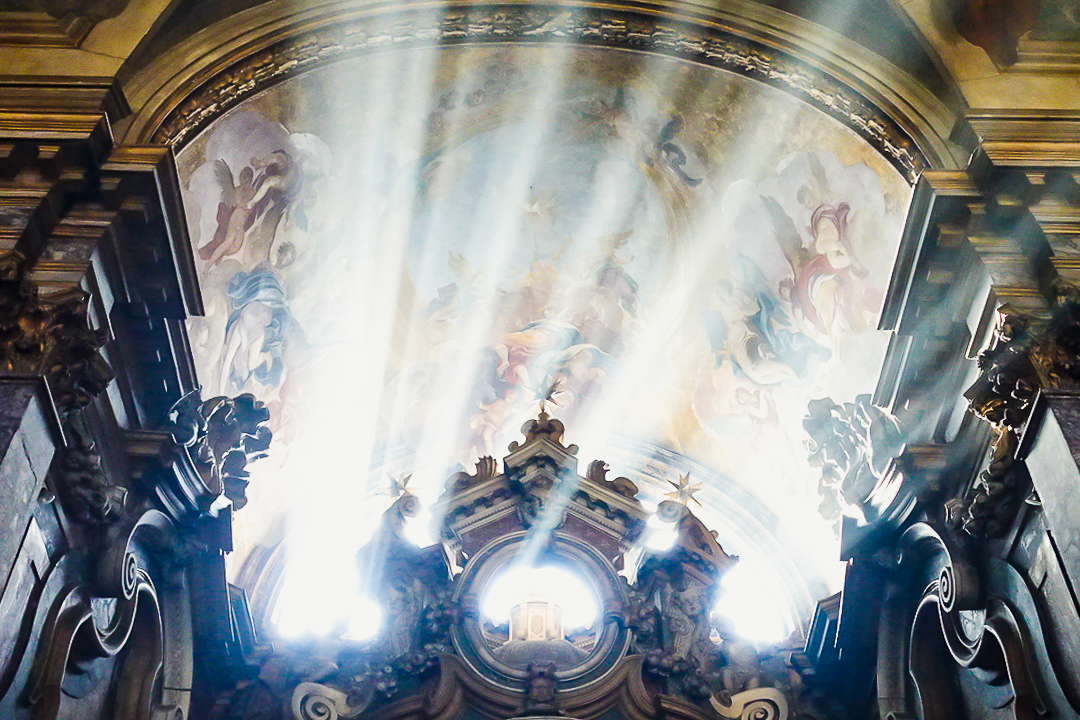
Church of Santa Maria di Nazareth, also known as the Church of the Carmelitani Scalzi
Stage 1: Jewish Ghetto
The Venetian Ghetto is the oldest Jewish quarter in Europe, established by the Serenissima on 29 March 1516. Today it is one of the liveliest and busiest areas in the city, where the five synagogues and the Jewish Museum illustrate the traditions of Venice's historic Jewish community.
The word “ghetto”, now used all over the world, derives from the ancient Venetian term “gèto”, i.e. cast of molten metal, which indicated the place where Venice’s Jews were forced to live by the government: the area was originally home to foundries where metal was worked to produce cannons, before these activities were transferred to the Arsenale. For almost three centuries, between 1516 and 1797, Jews could not live outside the confines of the Ghetto. At sunset, heavy gates closed the two entrances to the Campo del Ghetto Nuovo, then reopened at dawn. With the fall of the Republic and the advent of Napoleon, the ghetto gates were removed, along with the obligation for Jews to live there. The introduction of the Fascist racial laws in 1938 marked the start of persecution by Nazis and Fascists in Venice, ultimately leading to the deportation between 1943 and 1944 of 246 Venetian Jews, of whom only eight returned from the extermination camps. A memorial tablet in Campo del Ghetto Nuovo commemorates the Venetian Jews who were captured and deported. The square is also home to the bronze bas-reliefs known as the Holocaust Monument, the work of the Lithuanian sculptor Arbit Blatas.
Enter the Jewish Ghetto through the sottoportico of the Ghetto Vecchio, where signs of the hinges from the gates that closed the Ghetto island at night can still be seen in the stone jambs. Because of the tight spaces, the houses of the Venetian Jews were built upwards, reaching up to eight floors in height. An interesting fact regarding the Ghetto Vecchio (Old Ghetto) and the Ghetto Nuovo (New Ghetto): the first to be founded in 1516 was the present-day Ghetto Nuovo, home at the time to the New Foundry (gèto nuovo) from which it took its name. Later, due to population growth, the Ghetto Vecchio was built on a site formerly occupied by large vegetable plots and gardens: Calle dell’Orto, located near the Ponte del Ghetto Vecchio, is evidence of this.
The Ghetto Vecchio and Ghetto Nuovo are home to five public synagogues, each associated with a different nationality and each with its own rituals and welfare associations: the Scuola Grande Tedesca and the Scuola Canton built by the Ashkenazi Jews, the Scuola Italiana, and the Scuola Levantina and the Scuola Spagnola built by the Sephardi Jews. Only two of these five synagogues are still used by the Jewish community today: the Levantine synagogue and the Spanish synagogue, both in the Ghetto Vecchio. These synagogues, which are more commonly known as scuole, or schools (because the ground floor was used for study, while the upper floor was used for prayer), are some of the most beautiful in Europe thanks to their richly decorated interiors, and are still meeting places for the Jewish community in Venice today.
When you enter the Ghetto Vecchio, you will find yourself near the Campiello delle Scuole, home to the Scuola Levantina, founded in 1538, and the Scuola Spagnola, the largest of the synagogues in the Ghetto, dating back to the second half of the sixteenth century. Continuing along the calle, you will come to the Ponte del Ghetto Vecchio, which will lead you onto the island of the Ghetto Nuovo. This area was originally only accessible via this bridge and the bridge you encounter when coming from the nearby Callesele. Here too there is a sottoportico that still bears signs of the gates that separated the ghetto from the rest of the city. It was not until 1865 that the third bridge was built between Campo del Ghetto Nuovo and Fondamenta degli Ormesini. You can still see two small houses here to the right and left of the bridge, built during the Second World War to oversee the ghetto.
The Campo del Ghetto Nuovo differs from other Venetian squares in that it is entirely surrounded by tall houses, with no monumental building to attract attention. There are three wells and three pawnshops in the Campo del Ghetto Nuovo. It is also home to the Jewish Museum and three synagogues: the Scuola Grande Tedesca, which is the oldest, established in 1527, the Scuola Canton, dating back to 1531, and the Scuola Italiana, built in 1575. The synagogues in the Ghetto Nuovo are not recognisable from the outside because they are located on the upper floors of pre-existing buildings, due to lack of space.
To continue the itinerary, head towards the Ponte del Ghetto Nuovo, which leads to Fondamenta degli Ormesini.
Useful information:
- Jewish Museum: Sunday to Friday 10.00 a.m. – 5.30 p.m.; closed on Saturdays and Jewish holidays. Full-price ticket €10. Guided tours with a fixed start time are available (between 11.30 a.m. and 5.30 p.m. on Thursdays and between 10.30 a.m. and 4.30 p.m. on other days) at the Scuola Levantina and the Midrash Luzzatto. See the website for more information https://www.museoebraico.it/

The Jewish Ghetto
Stage 2: Ghetto - Church of Santa Maria della Misericordia
After crossing the bridge, you come to Fondamenta degli Ormesini. This lively area, packed with osterie, bàcari and cicchetterie (Venetian bars and eateries), is popular with university students and young people. Continuing to the right, on the opposite side of the rio, or minor canal (just beyond the third bridge), you will come to the Squero Casal ai Servi, one of Venice’s oldest “squeri da sotil” (boatyards). It ceased production in 1920 and has been the headquarters of the Associazione Arzanà since 1996. The yard, which can be visited by appointment, contains collections created as a result of salvage work, discoveries and donations made by private individuals and boats moored there temporarily.
Continuing all the way along the fondamenta (canal bank), you will find yourself in Campo della Misericordia, where you will see the Scuola Nuova della Misericordia, one of Venice’s six scuole grandi, built to meet the needs of the Augustinian Misericordia confraternity. Built from 1534 onwards to a design by Jacopo Sansovino, it was inaugurated in 1583, although the exterior was unfinished. After being suppressed in 1806, it went on to become the headquarters of the Municipal Archives and, later, in 1925, it was used as a sports hall for the city’s basketball club. Since 2016, following major restoration work, the Scuola Grande della Misericordia has reopened, the frescoes inside have been restored to their former glory and the interiors have been adapted to host events and exhibitions. Cinema enthusiasts might be interested to know that the dance party scene in the 2010 film The Tourist, starring Johnny Depp and Angelina Jolie, was shot inside the Scuola Grande della Misericodia.
Make your way down the canal banks adjacent to the Scuola Grande della Misericordia, then cross the wooden bridge, where you can visit the Church of Santa Maria della Misericordia and the Scuola Vecchia di Santa Maria della Misericordia. In the middle of the square, divided into areas framed with stone elements and paved with bricks laid in a herringbone pattern, you will notice a well dating back to the second half of the fourteenth century, on which three of the four sides feature pairs of kneeling brothers holding the emblem of their confraternity.
There is an interesting fact regarding the herringbone paving in Venice. In the past, the use of herringbone paving was very widespread, and was present even in Piazza San Marco. It was not until the eighteenth century that it was covered with trachyte. Today, in addition to the space in front of the Church of Santa Maria della Misericordia, you can find the same paving in front of the Church of the Madonna dell’Orto.
Looking onto the square is the Church of Santa Maria della Misericordia (otherwise known as Santa Maria di Valverde, probably in memory of the insula of the same name on which it stands), built in the tenth century with the adjoining abbey, then rebuilt in the thirteenth century and reworked several times. The tripartite facade, clad entirely in stone and embellished with sculptures, dates back to the second half of the seventeenth century and is characterised by a curvilinear tympanum that tops the central part of the building.
The church interior is now bare, and is used as a location for exhibitions and events.
Film fans will be interested to learn that the church was used in 1979 for the filming of the James Bond movie Moonraker, and again in 1988 for the filming of the horror movie Nosferatu.
Adjacent to the church is the Scuola Vecchia di Santa Maria della Misericordia, built in 1310 in the Augustinian convent complex. The present structure and the flamboyant Gothic facade, completed in 1451, are the result of further fifteenth-century interventions. In 1441, Bartolomeo Bon created a stone lunette with the Madonna of Mercy adored by the brethren, originally placed on the facade above the portal, then taken down in 1612 and now held at the Victoria and Albert Museum in London. Still visible today are two angels by Bon, holding a scroll that runs along the architrave of the main portal. To continue with the itinerary, go back to the Ponte della Misericordia.
Useful information:
- Squero Casal ai Servi – Headquarters of the Associazione Arzanà: book a guided tour at https://arzana.org/dove-siamo-come-trovarci/
- Scuola Grande della Misericordia: for current exhibitions, please see https://www.misericordiadivenezia.it/
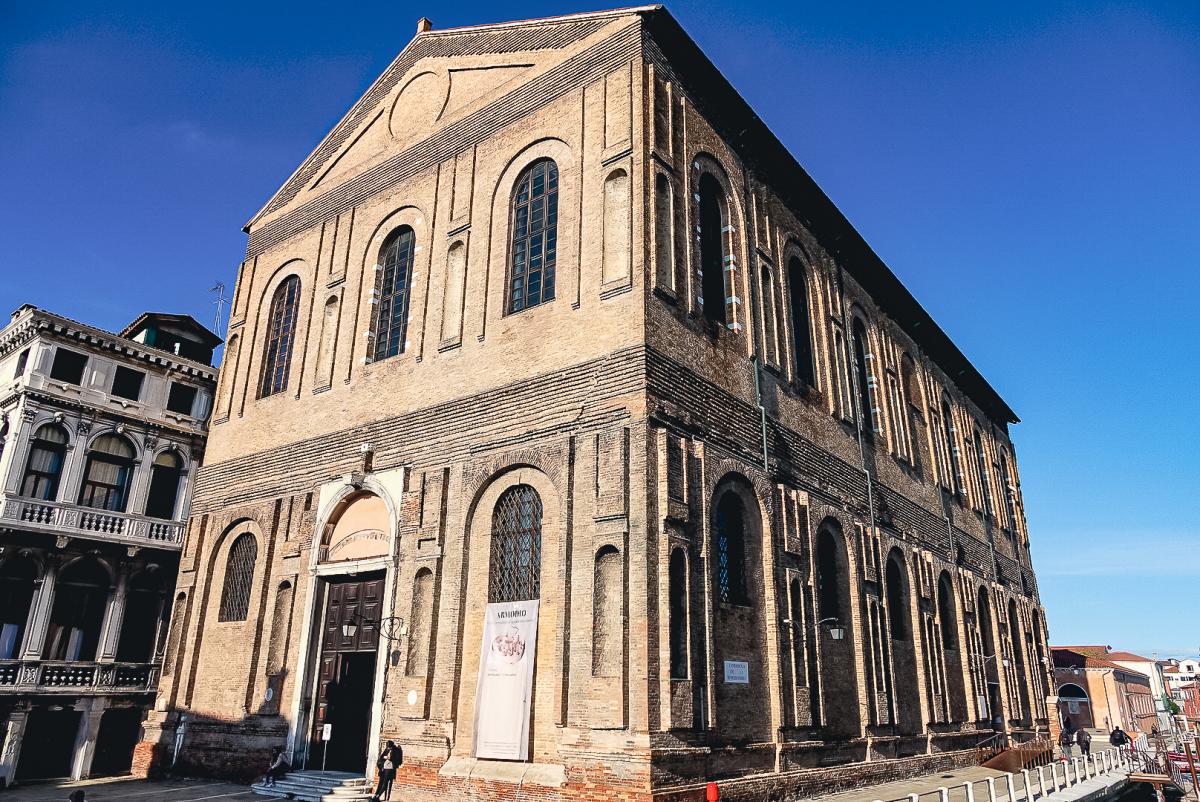
The Scuola Nuova della Misericordia
Stage 3: Misericordia - Ponte Chiodo - Campo dei Gesuiti - Calle Varisco
Returning towards the Scuola Grande della Misericordia, cross the Ponte della Misericordia and make your way to the Ponte Chiodo, the only bridge in the city that still has its original construction without parapets. There is only one other bridge with this construction in the entire lagoon: the Ponte del Diavolo (Devil’s Bridge) on the island of Torcello. In the past, none of the bridges in Venice had parapets. Indeed, originally and throughout most of the sixteenth century, the numerous small islands on which Venice is built were connected by simple wooden planks placed at the same level as the banks, over which horses and carriages could also pass. This mobile-type solution allowed boats to sail along the watercourses. Between 1569 and 1587, the Senate commissioned the Magistrato alle Acque (Water Authority) to reinforce the banks and foundations with Istrian stone. During the same period, the city progressively built stone bridges to replace the wooden ones.
To continue the itinerary, cross the second bridge over Rio San Felice and then turn left into Calle de la Racheta. Walk as far as Ponte Molin, and then turn right into Fondamenta de Santa Caterina, which joins Fondamenta Zen. Here you can see Palazzo Zen, which was created by joining three buildings together. It belonged to the Zen family, which included a number of sailors in the fourteenth century. The facade, once decorated with frescoes by Tintoretto and Schiavone, features Gothic and Renaissance architectural elements.
Leaving Palazzo Zen behind, you will come to Campo dei Gesuiti, with trees, benches and a seasonal fountain. The square has an unusual elongated shape that extends as far as the northern lagoon. The Crosiers (a hospitaller religious order) and later the Jesuits settled in this urban area. The square is home to various buildings of historical importance: the Oratorio dei Crociferi, the Jesuit convent complex and the Church of Santa Maria Assunta, known as I Gesuiti.
The Oratorio dei Crociferi, founded in the twelfth century along with the adjoining hospital, has a facade with a central oculus and a two-pitch roof. The lateral facade features a series of ancient tall chimneys. Inside the oratory there is a pictorial cycle by Jacopo Palma the Younger, dating back to the late sixteenth century, with stories of the Order of the Crosiers and of the doges Zen and Cicogna. The oratory was one of Venice’s first reference points for those seeking assistance and shelter.
Opposite the oratory is the former Crosier Convent, with an internal cloister, founded by the religious order in the twelfth century, rebuilt in 1514 after a fire and passed on to the Jesuits in 1657. Following the temporary suppression of the order in 1773, the complex was used as a school and, from 1807 onwards, as barracks. At present it is a university residence for students, researchers and professors at Venice’s IUAV and Ca' Foscari universities, with more than 250 beds and numerous communal services. It also accommodates visitors to the city in summer.
Adjacent to the Jesuit complex is the Church of Santa Maria Assunta, which originally belonged to the Crosiers and – like the convent complex – passed into the hands of the Jesuits in 1657. The Jesuits then renovated it in 1715–30. The church houses works by Palma the Younger, Jacopo Tintoretto and Titian. The imposing Baroque facade was built in around 1730 to a design by Fattoretto, financed by the Manin family.
From Campo dei Gesuiti, you can continue in the direction of Fondamenta Nuove, where you will find connections to the islands in the northern lagoon (Murano, Burano, Torcello, Sant’Erasmo, etc.).
In order to reach the next point of interest from here, you will need to make your way through numerous calli. Cross the Ponte dei Gesuiti and take Salizada Seriman, turn left into the second side street in Calle Venier, cross the Ponte de l’Acquavita and continue on to Campiello della Pietà. From here, take Calle Nova, one of the narrowest streets in the city, and go straight ahead until you reach Corte Contarina. Once in Corte Contarina, turn into Calle Mora on the right and walk to Campiello della Madonna. From here, cross the Campiello and continue right into Calle Morandi. At the end of the street you will find yourself in Calle Varisco. Turn right to reach the narrowest point of Calle Varisco, which at 53 cm wide is the narrowest street in Venice. The bravest among you can follow it all the way to the canal. Turning back towards the left you will come to Campiello Stella. Cross the square towards the right, in the direction of Campiello Widmann, and from here continue towards the right in the direction of Rio Terà dei Biri or del Parsemolo, following the Sottoportego del Magazzen. Once you reach the bridge, do not cross it, but turn left into Calle Larga Giacinto Gallina, which will take you directly to Campo San Giovanni e Paolo, in the Castello district.
Useful information:
- Church of Santa Maria Assunta dei Gesuiti: Monday to Friday 10.00 a.m. – 12.00 noon and 4.30 p.m. – 6.30 p.m.; Saturday and Sunday 10.00 a.m. – 12.30 p.m. and 3.00 p.m. – 7.00 p.m. http://events.veneziaunica.it/it/content/chiesa-di-santa-maria-assunta-detta-i-gesuiti
- Oratorio dei Crociferi: https://www.gioiellinascostidivenezia.it/i-gioielli/oratorio-dei-crociferi/
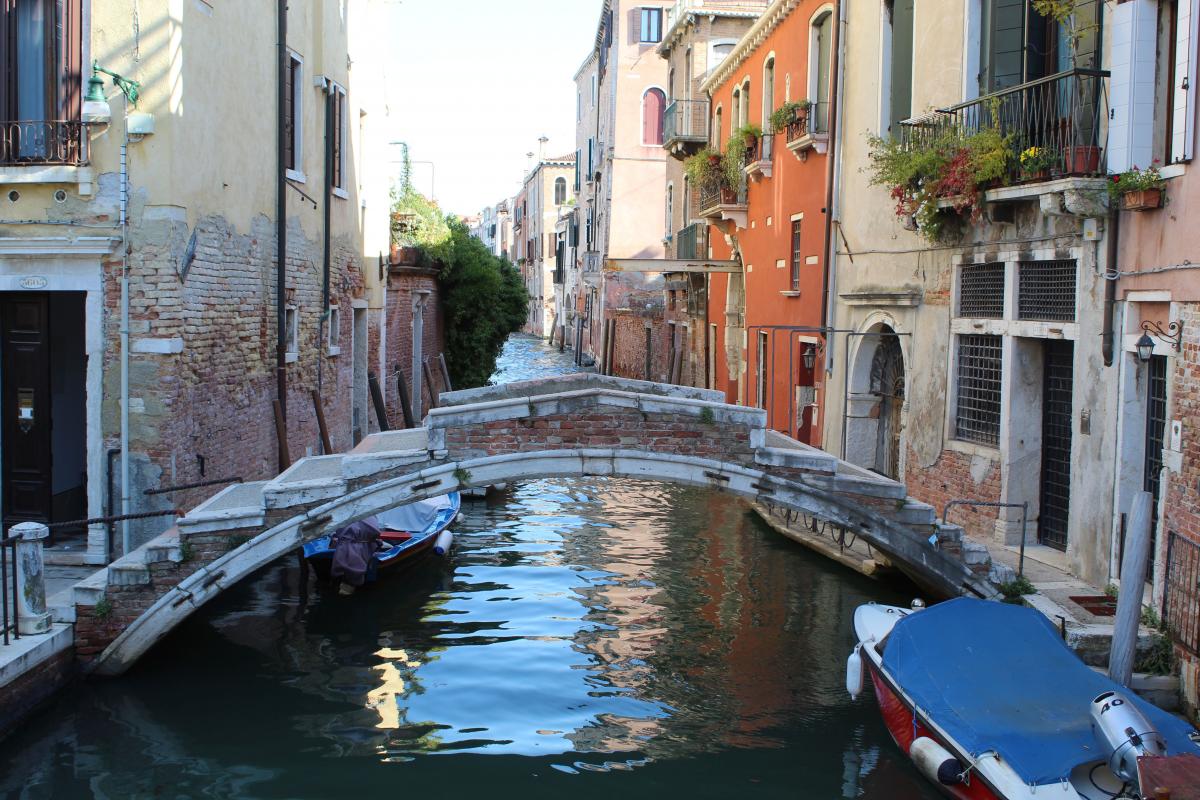
Ponte Chiodo, the only bridge in the historic centre without parapets
Stage 4: Basilica of Santi Giovanni e Paolo - Scuola Grande di San Marco
Campo Santi Giovanni e Paolo is one of the largest and most significant spaces in the city, home to important civic and religious buildings. The square was originally a marshy area, donated by the Republic of Venice to the Dominican friars, who reclaimed it in 1234, creating a large, well-defined urban space. At the centre of the square stands the bronze equestrian monument of Bartolomeo Colleoni, by Andrea Verrocchio, dating to 1481–1488, while nearby there is a lovely well decorated with high-relief festoons and putti, installed here in 1824. The Basilica of Santi Giovanni e Paolo, in the background, is one of the city’s finest examples of Gothic architecture and the place where the doges’ funerals were celebrated. The basilica is considered the “Pantheon of the Doges” because of the numerous funerary monuments of doges and other illustrious figures from the city housed there. It also contains works by artists of the calibre of Giovanni Bellini, Lorenzo Lotto, Giovan Battista Piazzetta, Pietro and Tullio Lombardo, and Bartolomeo Vivarini, as well as four canvases by Veronese.
To the left of the church facade you will see the Scuola Grande di San Marco, founded as the Scuola dei Battuti, the most imposing of Venice’s scuole grandi. Dating back to 1260, it became so influential that it took the name of the city’s patron saint. Inside, there is a vast hall on the ground floor, with its beamed ceiling supported by a succession of columns. The upper floor consists of the Sala del Capitolo (chapterhouse) and the Sala d’Albergo, which contain numerous paintings by Tintoretto and Giovanni and Gentile Bellini. Observing the ceiling of the chapterhouse, you will notice a number of coats of arms and symbols: in the centre is a nimbed lion, the only one in the whole of Venice; the initials SMV, indicating Santa Maria Valverde, the current Scuola della Misericordia; the eagle of the Scuola Grande di San Giovanni Evangelista; the initials SR, indicating the Scuola Grande di San Rocco, and two circles symbolising the Scuola Grande della Carità, the current Accademia di Belle Arti (Academy of Fine Arts).
In 1485, a disastrous fire destroyed it entirely and the reconstruction was entrusted to the architect Pietro Lombardo, later replaced by Mauro Codussi, while the sculptural cladding of the facade was commissioned to Gentile and Giovanni Bellini.
An interesting fact: the medical library in the chapterhouse has very ancient origins and contains almost 18,000 volumes, with writings by Hippocrates, Pliny, Falloppio and Ludovico Ariosto. Today the scuola is the entrance to the hospital and has been open to the public again since 2013.
You might like to take a rest in this square, which has some benches and a little fountain behind the apse of the basilica (in Calle Luigi Torelli, also known as Calle de la Cavallerizza). It is also worth noting that at this point, should you so wish, you can join the itinerary entitled “Naval art, craftsmanship and popular traditions: Venice’s Castello district”.
Useful informazioni:
- Scuola Grande di San Marco: Tuesday to Saturday and the first Sunday of the month 9.30 a.m. – 5.30 p.m. Full-price ticket €8. https://www.scuolagrandesanmarco.it/
- Basilica of Santi Giovanni e Paolo: weekdays 9.00 a.m. – 6.00 p.m.; Sundays and public holidays 12.00 noon – 6.00 p.m. Full-price ticket €3.50. https://www.santigiovanniepaolo.it/
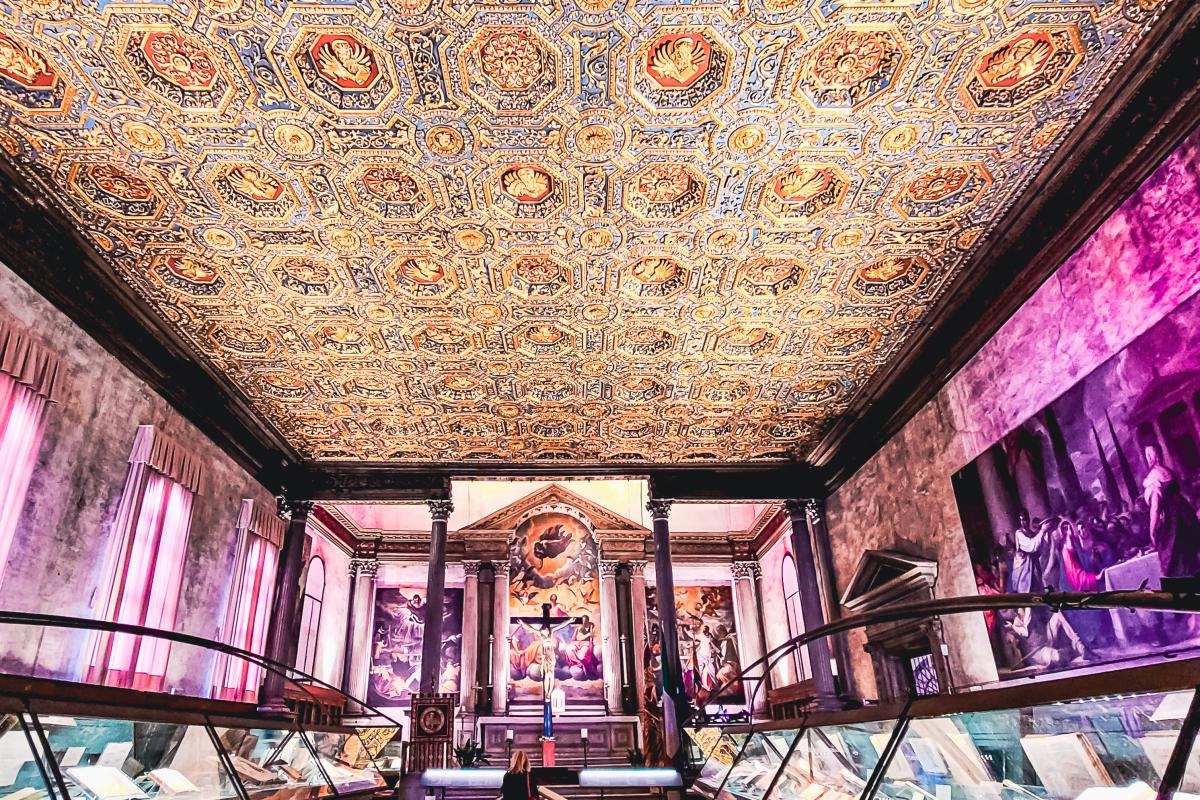
Scuola Grande di San Marco
Stage 5: Campo Santi Giovanni e Paolo - Palazzo Tetta - Santa Maria Formosa
The next stop is Santa Maria Formosa, but before continuing, we suggest a walk along Barbaria de le Tole to discover some of the craft shops in the area. Take Salizada San Zanipolo, the street that runs along the right side of the Basilica of Santi Giovanni e Paolo and joins Barbaria de le Tole. There is an interesting fact regarding the name of Barbaria de le Tole: this is where wooden boards used to be planed, removing the “barbs”, before they were used by the many carpentries that once looked across the northern part of the lagoon.
In general, the route from here to Campo Santa Maria Formosa is full of small shops selling ceramics, jewellery, papier-mâché masks, glassware and textiles.
At the beginning of the street, near the Basilica of Santi Giovanni e Paolo, is the Complesso dell'Ospedaletto, which consists of the Church of Santa Maria dei Derelitti, the Scala dei Sardi (Sardi Staircase), the Cortile delle Quattro Stagioni (Courtyard of the Four Seasons) and the Sala della Musica (Music Hall).
To continue the itinerary, return to Campo Santi Giovanni e Paolo, and turn into Corte Veniera, which joins Fondamenta dei Felzi. From here, turn left in the direction of Ponte dei Conzafelzi, which looks onto the beautiful Palazzo Tetta, the only building in Venice that looks onto canals on three sides.
Cross the bridge and walk down Calle Bragadin, then turn right onto Calle Lunga Santa Maria Formosa, a lively street lined with a wide variety of shops, including bakeries, shops selling hand-decorated artefacts (including fair-trade and charity items), masks, glass, mosaic and paper works. From here you will arrive directly in Campo Santa Maria Formosa, the religious and civic heart of the city, and the point where three sestieri (districts) converge: Cannaregio, San Marco and Castello (to which the square belongs). This was once one of the liveliest places in the city, hosting popular festivals (including the bull hunt), as well as home to the scuole of some of the most important commercial and craft guilds. Looking onto the square are numerous buildings of architectural merit, dating back to different eras: Palazzo Ruzzini, Palazzo Donà, Palazzo Vitturi and Palazzo Malipiero.
In the centre of the square is the Church of Santa Maria Formosa, built in 639 at the behest of St Magnus, Bishop of Oderzo, to whom the shapely Virgin is said to have appeared.
The current building, erected in 1492, is a masterpiece by Mauro Codussi, thanks to which the architect introduced the sculptural and spatial vision of the Tuscan Renaissance in Venice for the first time. The plan, in the shape of a Latin cross with three aisles, is aligned with the foundations of the seventh-century church. Indeed, the ninth-century renovation, during which the church was provided with a dome and a Greek cross plan, is still partly visible.
The result is a well-structured space, strongly characterised by the attractive central focus of the church, in which the clear light combines with the dense fretwork of the load-bearing walls, making the complex vaulted and domed ceiling seem to float.
Different styles were chosen for the two external facades, both commissioned by the Cappello family: the one facing the water, dated 1542, is reminiscent of classical style, while the other facing the square, dated 1604, is Baroque.
The artworks include: in the chapel of the Scuola dei Bombardieri, the Polyptych of St Barbara by Jacopo Palma the Elder (1480–1510), a work that made the artist’s name; the Last Supper by Leandro Bassano (late sixteenth century); in the Chapel of the Concezione, the famous Triptych of the Madonna della Misericordia, in the style of Mantegna, by Bartolomeo Vivarini of Murano (1473).
The Oratory houses a Madonna and Child with St Dominic by Giambattista Tiepolo (eighteenth century).
Interesting facts: Baldassare Galuppi worked as an organist in the church in 1722. The ancient organ was destroyed by an Austrian bomb during the First World War, in 1916.
A monstrous grotesque head was placed at the keystone of the entrance door to the bell tower, because it was believed to ward off the devil, who enjoyed ringing the bells.
The dome you can see today was rebuilt twice: the first time in 1668 after an earthquake, the second time in 1921 after a bombing raid in 1916, which partially destroyed the church and a number of paintings. The church was also the seat of several religious and professional schools, including the Scuola dei Casselleri, i.e. the makers of chests not only for transporting goods, but also for wedding trousseaus.
In the immediate vicinity is the Palazzo Grimani Museum, the ancient home of the Grimani family, one of the most famous patrician families that produced three Venetian doges. Purchased by the state in 1981, the palace was reopened to the public in 2008 after a long period of renovation. Today it owes its fame to its frescoes, stucco work and precious marble sculptures, as well as to the collection of over 130 antique sculptures in the Tribuna Grimani.
The last recommended detour, skirting the left-hand side of the church from Santa Maria Formosa, is the Campiello Querini Stampalia, where, on the other side of the canal, you can admire Palazzo Querini Stampalia, built in 1528. Since 1869, the building has been the seat of the Fondazione Querini Stampalia and was bequeathed to the city of Venice by Count Giovanni, the family’s last heir. Today it houses: the library, open until late at night on public holidays, the home-museum and a temporary exhibition space. It contains numerous paintings, including Giovanni Bellini’s Presentation at the Temple and a collection of paintings by Pietro Longhi and Gabriel Bella, whose canvases depict episodes from eighteenth-century Venetian life. The foundation’s garden is named after Carlo Scarpa, the architect who redesigned it in the early 1960s. It features references to Moorish and Japanese styles and to the traditions of the lagoon, such as a well, a Gothic lion and capitals.
Useful information:
- Church of Santa Maria Formosa: Monday to Saturday 11.30 a.m. – 1.30 p.m. and 2.30 p.m. – 5.00 p.m. www.chorusvenezia.org/chiesa-di-santa-maria-formosa
- Museo Fondazione Querini Stampalia: Tuesday to Sunday 10.00 a.m. – 6.00 p.m. Closed on Mondays. Full-price ticket €14. http://www.querinistampalia.org/ita/home_page.php
- Museo di Palazzo Grimani: Tuesday to Sunday 10.00 a.m. – 6.00 p.m. Closed on Mondays. Full-price ticket €15. https://polomusealeveneto.beniculturali.it/musei/museo-di-palazzo-grimani
- Complesso dell’Ospedaletto: https://www.gioiellinascostidivenezia.it/
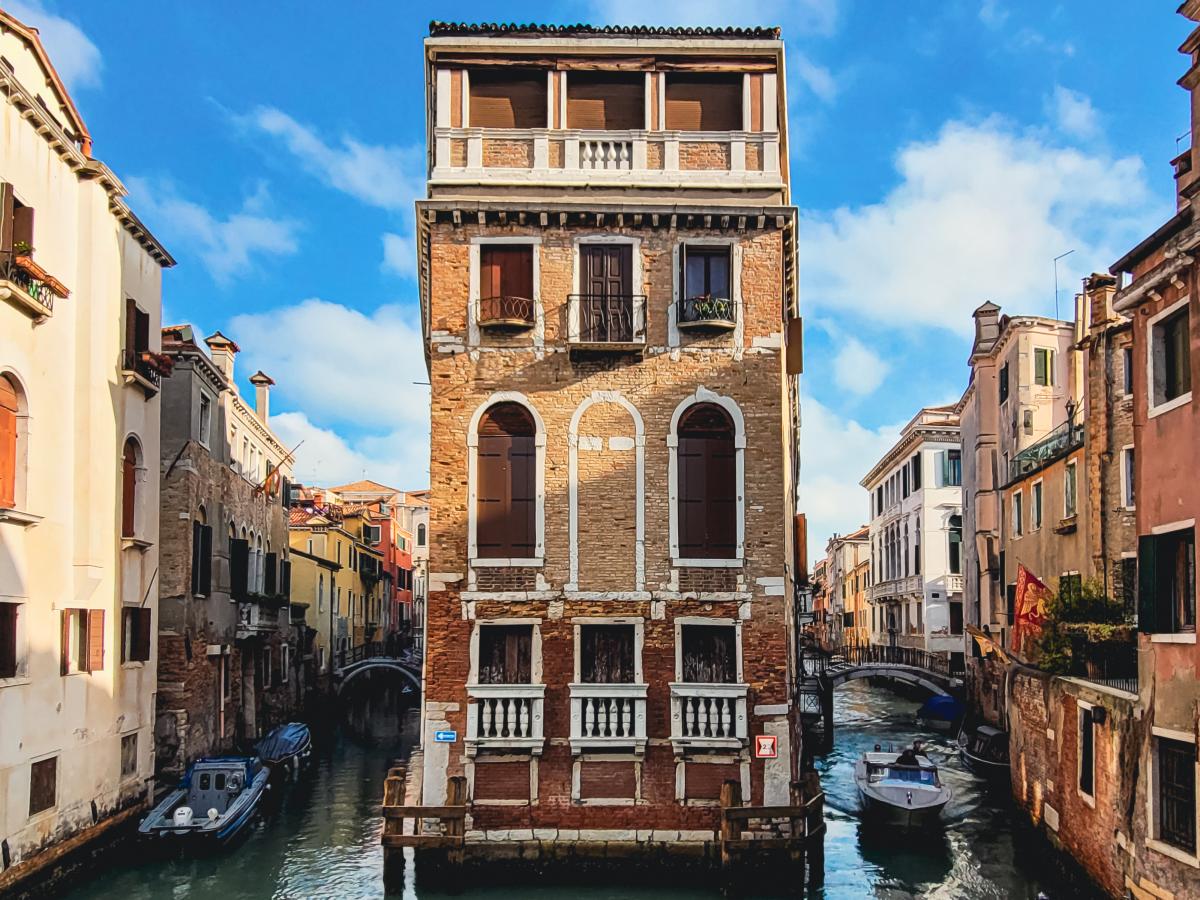
Palazzo Tetta, the only building in Venice surrounded by water on three sides
Stage 6: Campo Santa Maria Formosa - Scala Contarini del Bovolo - Campo Manin
To reach the next stage, go past the main facade of the Church of Santa Maria Formosa and around the bell tower, and you will see the secondary facade with the Ponte de le Bande opposite. Cross the bridge and walk along Calle de le Bande and Calle al Ponte de la Guerra, then cross the Ponte de la Guerra that leads to Campo de la Guerra. At the far side of the square, you will find yourself behind the Church of San Zulian. From Campo de la Guerra, turn right into Calle San Zulian and then take an immediate left turn, walking along the side of the church until you reach the centre of Campiello San Zulian.
From here, walk around the church and make your way past it to Campo San Zulian. Turn right into Marzaria San Zulian and continue as far as the Ponte dei Bareteri (the first bridge you come to). From the top of the bridge, make your way through a narrow passage next to the canal and you will find yourself at the Ponte dei Pignoli (parallel to the Ponte dei Bareteri). Cross it and continue left into Fondamenta Morosini, following it all the way to Calle de le Ballotte on the right. At the end of the short street, turn left and cross the Ponte de le Balote, or Ballotte, and continue along Calle dei Monti. Turn right and then turn left into Calle del Magazen (the first on the left), going straight on until the end (the street narrows after a crossroads). Turn left again into Calle dei Fuseri and then right into Calle Vida or Calle delle Locande (the first street on the right).
Continue for a few dozen metres and then turn left into a small street that will take you to the imposing Palazzo Contarini dal Bovolo with its majestic staircase (follow the yellow signs for the Scala Contarini del Bovolo).
The Scala Contarini del Bovolo is an elegant spiral staircase (“bòvolo” in Venetian) made from Istrian stone, which we know to pre-date the sixteenth century thanks to a source that dates it to 1499 and due to the fact that the staircase features in the perspective view by Jacopo de Barbari. The staircase was built at the back of Palazzo Contarini by the Venetian craftsman Giovanni Candi, at the behest of Pietro Contarini. Although the building is in a markedly late Gothic style, the staircase adds significant Renaissance influences, in the wake of the new fashion brought to the city by Tuscan artists and craftsmen, so much so that it is considered by some scholars to be an expression of the connection between the late Gothic and the early Renaissance in Venice.
Despite the central position of the building, it did nothing to enhance the family’s prestige, because the main facade looked onto a minor canal, the Rio di San Luca. In addition to its practical role, the staircase was also intended to boost the family’s image and renown.
The building is located in a strategic position: equidistant from Rialto, the economic heart of Venice, and Piazza San Marco, the political centre. Going up to the belvedere, you can enjoy a splendid 360° view that embraces the domes of San Marco and Santa Maria della Salute, offering a breath-taking vision of the city’s roofs and bell towers.
In the courtyard, there is a small garden with arches and wells from the Church of San Paternian (demolished in the nineteenth century when the square where it stood was transformed and named after the patriot Daniele Manin), including a beautiful Venetian-Byzantine well from the eleventh century.
This stage continues from Scala Contarini del Bovolo in the direction of Campo Manin. From the staircase, turn back onto Calle Vida and, turning left, you will find yourself directly in the square. Here you can see the monument to Daniele Manin, a Venetian patriot during the insurrections of 1848 and 1849, and Palazzo Nervi-Scattolin, a modern architectural structure, now headquarters of the Cassa di Risparmio di Venezia savings bank. The building stands on the site originally occupied by the church that gave the square its name, San Paternian. The square has undergone major transformations over the years, leading to the demolition of various buildings, including some houses, the church and the bell tower.
Useful information:
- Scala Contarini del Bovolo: https://www.gioiellinascostidivenezia.it
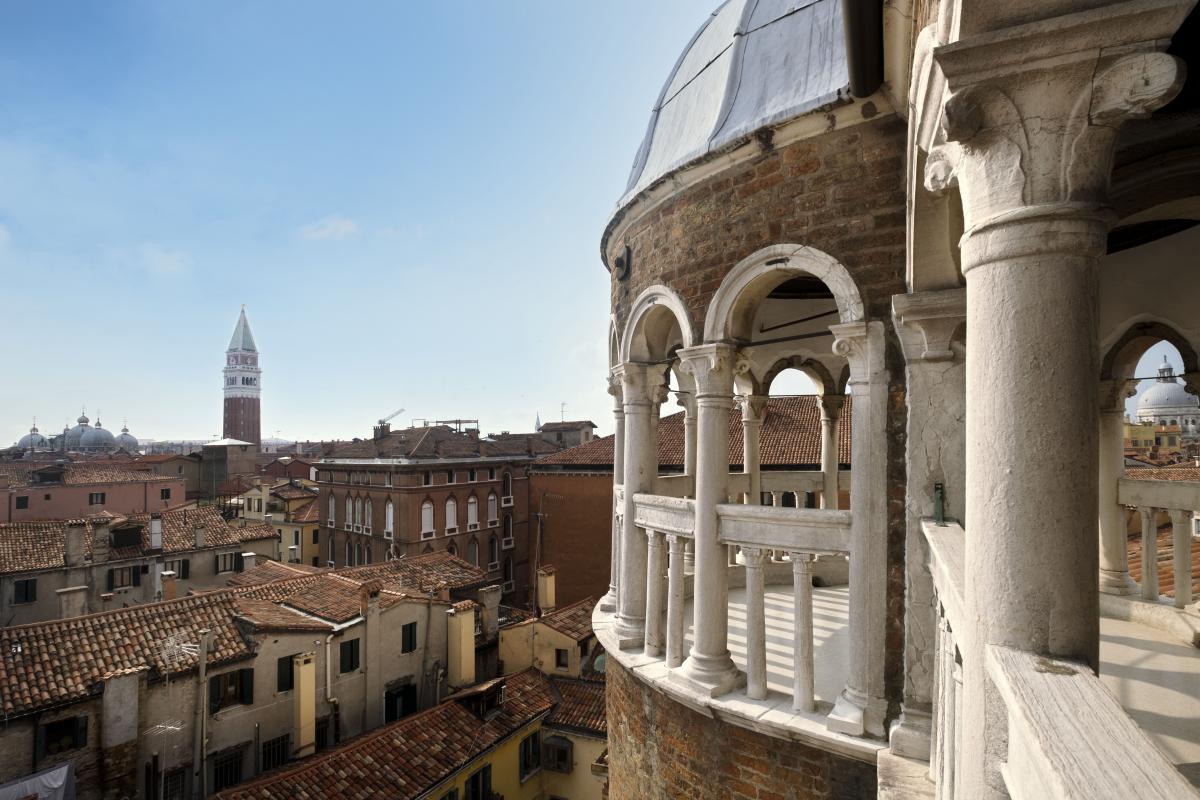
Scala Contarini del Bovolo
Stage 7: Campo Manin - Palazzo Fortuny
From Campo Manin, cross the Ponte della Cortesia and enter Calle della Cortesia, before taking an immediate right into Salizada della Chiesa or del Teatro, which will lead you to Campo San Beneto. This square has a unique feature: the well curb preserves the characteristic quadrangular elevation that was used to facilitate the collection of rainwater, with a large well in the middle: a large space was required for the construction of a well in order to install the cistern and the manholes for the collection of water, but above all the mount had to be in a sufficiently high position to avoid being reached by seawater in the event of a high tide.
From Campo San Beneto, you can admire Palazzo Pesaro-Fortuny, also known as Palazzo degli Orfei: it was the last home of the patrician Pesaro family before they moved to the Canal Grande. After the end of the Pesaro lineage, the building suffered a slow and constant decline until, in 1898, the Spanish artist Mariano Fortuny y Madrazo, fascinated by its beauty, decided to establish his own studio there, dedicated to artistic and scenic experiments. Restoration work began later, and the building became the home of the Fortuny family until 1949. Fortuny was an eclectic, creative character, who turned his interests to painting, set design and lighting technology, as well as creating fabrics and printed textiles together with his wife. The husband-and-wife team designed Delphos, the pleated silk dress that made Fortuny’s name around the world.
To learn more about Mariano Fortuny’s artistic textiles, in addition to visiting the building where the artist lived and worked and which today houses the Fortuny Museum, you can also book a guided tour of the historic headquarters of the fabric factory on the island of Giudecca. Materials, designs, fine fabrics and accessories are on display to the public in the showroom.
Useful information:
- Fortuny Museum: consult the website for opening hours https://fortuny.visitmuve.it/
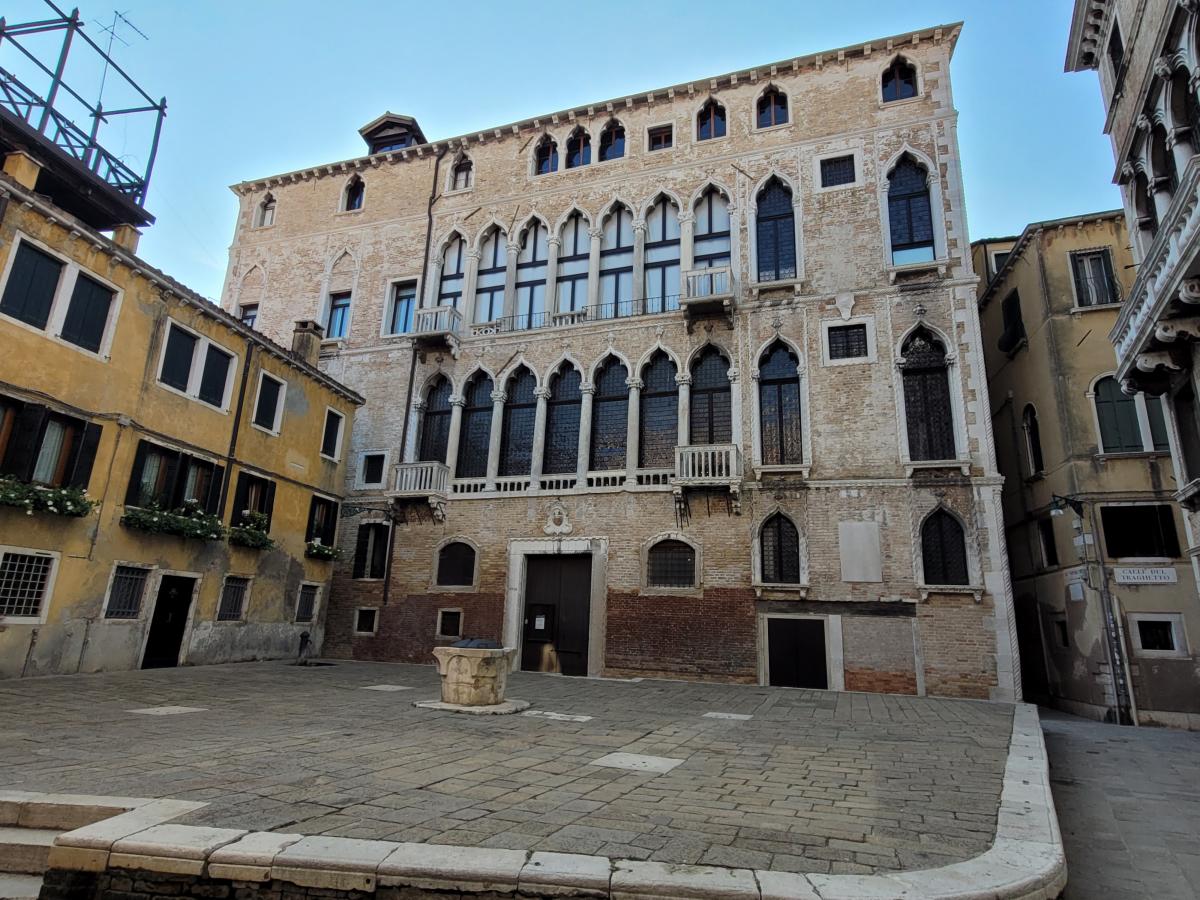
Facade of Palazzo Fortuny
Arrival: Palazzo Fortuny - Campo Santo Stefano - Campo San Samuele
To complete the last stage, go back to Calle della Cortesia, turn right and continue along Calle de la Mandola until you reach Campo Sant’Anzolo. Cross the square and then make your way over the Ponte dei Frati. Follow Calle dei Frati to Campiello Santo Stefano, where, on the left, you'll find the entrance to the Church of Santo Stefano, one of the most important examples of Gothic religious architecture.
When you come out of the church (you can also leave by the side exit), you’ll find yourself in Campo Santo Stefano, one of the largest squares in the city and a crossroads of routes to the left towards San Marco and straight on towards the Accademia. In the square, you will see two large eighteenth-century wells, which are almost identical (differing only in the central bottleneck) and the statue of Niccolò Tommaseo.
Towards the end of the square, you will come to Campiello Pisani on the left, home to Palazzo Pisani, the most imposing patrician palace in the city, second in size only to Palazzo Ducale (Doge’s Palace). Since 1897 it has housed the Conservatorio di Musica Benedetto Marcello, named after the composer Benedetto Marcello, born in Venice on 24 July 1686. The library is particularly noteworthy, among the richest to be found in any Italian conservatory: it houses more than 60,000 volumes, including autograph manuscripts by Vivaldi, Liszt and even Marcello himself.
In the 2006 film Casino Royale, starring actor Daniel Craig as secret agent James Bond, this building collapses following a shootout inside.
Looking onto Campo Santo Stefano is Palazzo Loredan, the historical seat of the Istituto Veneto di Scienze, Lettere ed Arti (Veneto Institute of Science, Literature and Art). Renovated in Renaissance style by Antonio Scarpagnino, the building houses a collection of marble busts and medallions in the atrium, with portraits of the most significant figures from the city’s history, including busts of Titian, Veronese, Palladio, Dante Alighieri and many others. The institute’s other seat is the nearby Gothic Palazzo Franchetti, overlooking the Canal Grande, characterised by a beautiful garden that can also be seen from the Ponte dell’Accademia. There is a small theatre on the second floor of this building: according to some, the young Mozart performed here during his trip to Venice in 1771.
From here, you can choose whether to continue your visit by linking up with the “Dorsoduro, art district: from Venetian origins to international contemporary art” itinerary, or to explore other points of interest in the city, such as Rialto or San Marco.
If you decide to make your way to Campo San Samuele, cross back over Campo Santo Stefano and, at the church of the same name, turn left into Calle delle Botteghe. The entire area between Calle delle Botteghe and Campo San Samuele is a succession of art galleries, design studios, local and Italian craft shops and modern antique shops. This area is also home to the historical archive of the long-established Rubelli weaving mill, renowned since 1889 for the production of passementerie, counter-cut velvets, handmade velvets, lampas and brocades. Ca’ Pisani Rubelli, which can be visited by appointment, contains over 6000 textile documents dating from the end of the fifteenth century to the first half of the twentieth century, and also includes the precious silk velvets made for the Royal House of Savoy in the early twentieth century.
Continue along Calle delle Botteghe and Calle Crosera until you come to an arch between two houses. Turn left into Salizada San Samuele and head straight down Calle de le Carrozze until you reach Campo San Samuele, where you can take a break on one of the benches, enjoying a magnificent view of the Canal Grande. Looking onto the square is Palazzo Grassi, which since 2006 has hosted exhibitions of contemporary artworks from the Pinault Collection, one of the most important in the world.
Useful information:
- Istituto Veneto di Scienze, Lettere ed Arti: http://www.istitutoveneto.it/flex/cm/pages/ServeBLOB.php/L/IT/IDPagina/1
- Palazzo Grassi: https://www.palazzograssi.it/it/
- Ca’ Pisani Rubelli: http://www.rubelli.com/it/archivio-storico/
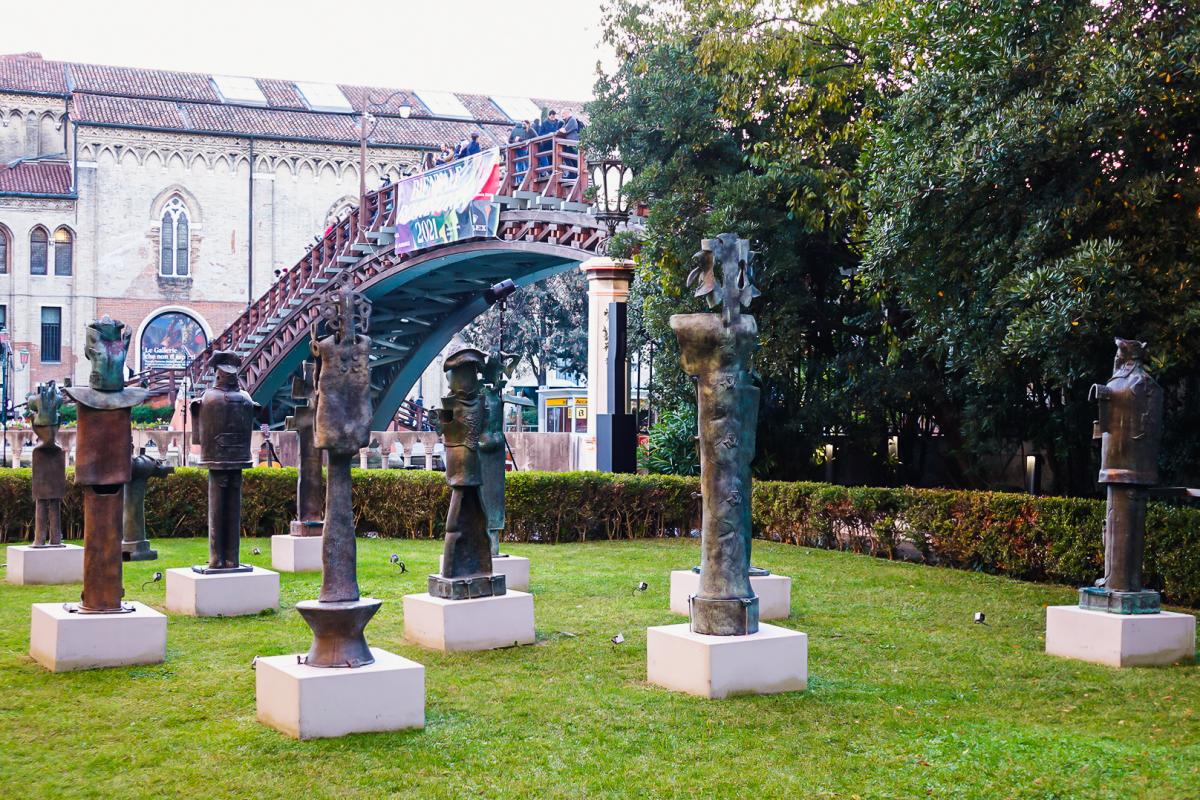
Palazzo Franchetti garden looking onto the Canal Grande
Sources
-
Guida Rossa Touring Club Italiano. 2005. Venezia. La biblioteca di Repubblica
-
Giulio Lorenzetti – Venezia e il suo estuario, 1974
-
1999. Calli, Campielli e Canali – Guida di Venezia e delle sue isole. Edizione Helvetia
-
Marina Crivellari Bizio. 2009. Campi Veneziani – Storia e segreti dei campi veneziani. Filippo Editore Venezia
-
Mariagrazia Dammicco. 2013. Guida ai Giardini Veneziani. La Toletta Edizioni.
-
Consultazione dei siti ufficiali dei principali punti di interesse



